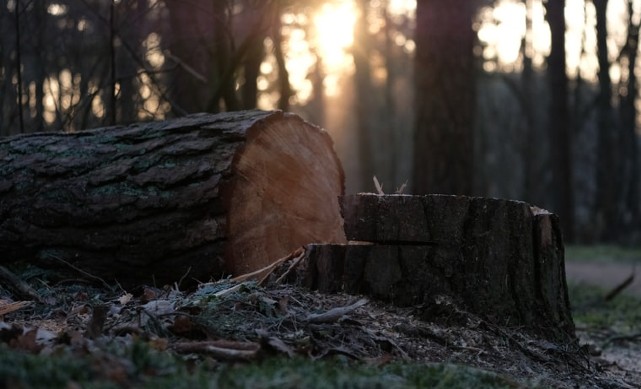
Some simple guidelines from Cronin’s Hardware & Agri Supplies for a safe and efficient way when dealing with a fallen tree on your property
During the recent months Ireland has seen its fair share of stormy weather resulting in trees being brought down. Sometimes it’s as natural as the tree just coming of age or the root system being weak but for most of the time it’s the elements that play the part. A tree that’s fallen on your property isn’t ideal, it might have provided shade, visual interest or had sentimental value but it’s not as bad as it seems. It can now serve a new purpose in heating up your home for next winter. While in most cases it’s recommended to bring in professionals to remove them, especially if the tree is near electrical services, but there are plenty of chainsaw owners out there that would have the skills to tackle the problem themselves, so if you’re one of theunlucky ones that this happens to hopefully this guide will help minimize any risks
The most important step, Safety first
Before you start it is extremely important that you carefully assess the size of the tree and where it fell. Most often it’s a partially fallen tree that poses more of a risk and trying to get it down safely can sometimes prove challenging. Having the right personal protective equipment is essential; Helmet, earmuffs, face shield and gloves should at least be worn and where possible a pair of protective chaps to protect your most vulnerable area, your legs. If you can, have somebody else there working with you, if you get stuck or suffer an injury, at least you’ll have someone there to remedy the situation. Use caution and always be aware where the tip of the chainsaw is at all times. Try and stand to the left of the saw in a way that your body is clear from the cutting attachment and always insure a firm grip is placed on the top handle so that in the event of a ‘’kick back’’ full control of the chain break is in order.
Operating the chainsaw
Have a quick check to make sure that everything is in working order; the chain’s tension, its sharpness, the bar and controls, this will contribute to how it performs. Don’t start a saw like your plucking the feathers off a live chicken. It needs to be controlled. Ideally it should be started on the ground. Engage the chain break first, put your foot into the rear handle, ensure a firm grip and proceed to start it, or alternatively with the rear handle safely anchored between your legs and proceed accordingly. Keep feet firmly planted as you work and never operate in an uncomfortable way that may cause injury to yourself or others.
Processing the fallen tree
The size of the chain and the overall power it can produce all contribute to the chainsaw’s capabilities. Ideally having two chainsaws on site will allow for a more controlled environment. A lighter saw, the Husqvarna 435 for instance can contribute to a more controlled cut while liming branches and the larger, more powerfull saw, the Husqvarna 560XP for processing the trunk. While the tree is on the ground there’s going to be a lot of tension within it so knowing where to make the cuts takes practice, and with that comes experience. You want to cut where the tension is pushing. If you’re not sure start the initial cut first and if you see the tree pinching, remove it and finish the cut on the other side. While removing the limbs, keeping the lower branches on the tree as you work through it can be an advantage as it will allow the tree to be off the ground minimizing the risk of damaging the chain on rocks or other debris that might cause the chain to become blunt or break. Another thing to note is that if the tree has fallen with the root attached, which in a lot of cases it does, it will have a tendency to fall back once the weight of the trunk is less than that of the root. Making your first cut close to the root will minimize the danger of a ‘’snap back’’. Know your escape route and make sure it’s clear when doing this.
Maintaining your chainsaw
After you have finished with the work involved, giving your chainsaw a little service before storing it will not only improve its condition but also its longevity, after all prevention is the best cure. The fuel mix has a shelf life of 3 to 6 months depending on the temperature, after that it degrades in quality so emptying it back into a sealed container is good practice. This can then be used on another 2-stroke engine, like a strimmers during the summer months. Clean in and around the bar cover, making sure to remove any buildup of saw dust and check that the oil port is clean. Inspect the air filter also to make sure it’s clean. Don’t blow on it; a quick tap on its side should suffice. It’s also good practice to tone the chain with a few passes using the appropriate file before putting the cover back on, it will set you up for its next use.
So now spring has finally arrived, and with that comes the promise of better weather. It gives us a chance to survey the property and to be aware of any damage that might have been missed or what might occur and to plan for the future. If you would like any more information or advice on chainsaws and safety gear, just drop into us at Cronin’s Hardware and Agri supplies and we will be more than happy to assist you.